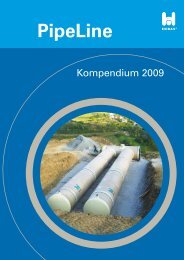PipeLine - Hobas Pipes
PipeLine - Hobas Pipes
PipeLine - Hobas Pipes
You also want an ePaper? Increase the reach of your titles
YUMPU automatically turns print PDFs into web optimized ePapers that Google loves.
h <strong>PipeLine</strong> | Compendium 2009 | Page 29<br />
Ready for Take-Off: h and Schiphol Airport<br />
CC-GRP <strong>Pipes</strong> for Renovating Airport Drainage System, NL<br />
Travelling by air is one of the safest, most accurate and fastest ways to<br />
travel. This reputation, however, makes high demands on air carriers as<br />
well as airports and one can easily deduce that these companies need to<br />
be equally demanding whenever they act as customers. Amsterdam<br />
Airport Schiphol is likewise known to be a critical client: a combination<br />
of high quality standards and short delivery times usually<br />
demands a great deal of contractors and suppliers. One may<br />
say that not every supplier comes into consideration to<br />
deliver to Schiphol.<br />
HOBAS ® CC-GRP Pipe Systems are being utilized at<br />
Schiphol Airport since 2003. The successful cooperation<br />
between HOBAS Benelux and Schiphol Airport<br />
led to an agreement in March 2008 to continue using<br />
HOBAS CC-GRP <strong>Pipes</strong> beneath the airport’s airside.<br />
Schiphol covers a total area of 2820 hectares, which<br />
is approximately 8 times the size of the Central<br />
Park in New York. With five runways and one small<br />
airstrip, the airside consists of 1.2 million m 2 asphalt<br />
and 3.8 million m 2 concrete. Stormwater is conveyed<br />
in 30 km culverts, 300 km stormwater<br />
sewers and 125 km concealed gutters – the complete<br />
drainage system totaling 455 km. Most of<br />
the reinforced concrete drainage underneath the<br />
airside’s paving has been installed in the 1960s.<br />
During the 1990s Schiphol Airport checked<br />
the condition of its old sewers. Video inspections<br />
showed cracks in the concrete pipe<br />
material. More examinations followed detecting<br />
the severest damages in areas that<br />
are most heavily frequented by arriving and<br />
departing planes. The traffic load condition was<br />
therefore reevaluated with the conclusion that<br />
the Boeing 747 is mainly responsible for the<br />
damages to the reinforced concrete pipes.<br />
Renovation Plan<br />
Due to this situation and bearing in mind that the airport will<br />
have to be able to cope with larger aircraft such as the new Airbus<br />
380, Schiphol opted for a renovation plan based on new requirements.<br />
Static calculations were thus made using the aircraft class DAC 750 with<br />
a maximum weight of 750 tons. This class meets the requirements for the<br />
traffic loads of the latest generation of aircrafts.<br />
The plan involved renovating all concrete pipes beneath the paved airfield.<br />
Heavily damaged pipes beneath runways and taxiways were prioritized and<br />
involved a variety of diameters ranging from 400 to 1500 mm at a total of<br />
35 track crossings.Schiphol established a separate plan for each runway and<br />
taxiway for which the pipe section running directly under the airstrips were



